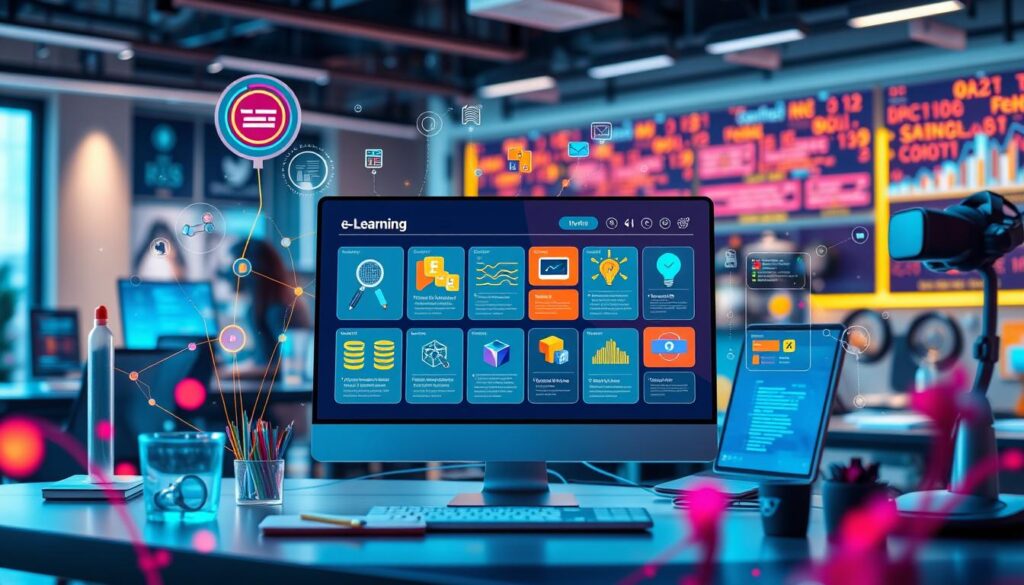The education world is quickly changing. There’s a big focus on e-learning platform development. This includes making education exciting, varied, and able to grow. Developers are working hard. They create custom online learning software. This software helps with the change to digital and pushes educational technology development forward.
They make everything from complex Learning Management Systems (LMS) to full Learning Content Management Systems (LCMS). These tools are leading the way. They are changing how we learn, teach, and connect with information.
There’s a huge need for custom education software now. This software must offer personal and fun learning moments. It also uses strong data analysis. Educational bodies and businesses need to use advanced e-learning creation tools. These tools help serve all kinds of learners. They improve the education journey. This lets these groups meet the needs of today’s online learners.
Key Takeaways
- Customized virtual learning software is key to modern education.
- High demand for engaging and interactive e-learning platform development.
- Educational technology development is critical for personalized and gamified learning experiences.
- Investment in authoring tools and LMS/LCMS can significantly enhance digital learning.
- Data analytics is a cornerstone in evolving e-learning strategies and systems.
- Scalable e-learning solutions are essential for the growth and diversity of educational offerings.
Understanding the Importance of Software Development in E-Learning
The global e-learning market is set to reach $1 trillion by 2032. This highlights the vital role of software development for online learning platforms. These platforms need to be scalable, high-quality, and effective.
As more educational and corporate groups use digital tools, the success of online learning depends on its tech foundation.
The Growth of Online Learning
Online learning has seen a huge jump in demand. For example, Coursera’s user sign-ups rose by 438% in five years. This boom is due to more people accepting online education, especially after the pandemic.
In the U.S., 73% of students prefer online classes now. By 2024, online university education could be worth $120.70 billion. This growth calls for more custom LMS development.
Key Features of Successful E-Learning Platforms
Great e-learning platforms share key qualities. These include user-friendly designs, strong authoring tools, and detailed analytics. These aspects encourage online course creation tools.
Platforms like Elucidat excel by ensuring their content is top-notch, quick to create, and scalable. They help organizations make effective e-learning programs. Adding AI and VR makes learning personalized and more engaging.
The Role of Technology in Education
Edtech has grown to serve a wide range of learners. It includes cloud-based services and LMSs with great authoring tools. These innovations make content more accessible and engaging.
Accessibility is a big focus. Over 40% of top companies use edtech for training. This is vital for offering education to everyone, including those with disabilities. New developments and interactive elements help make this possible.
Choosing the Right Software Development Company
Finding the right e-learning platform development partner is crucial in the fast-growing tech education market. The choice deeply affects both the start-up phase and future success of digital learning.
Factors to Consider
Choosing LMS integration and ed-tech development firms requires looking at various aspects. Focus on their tech skills, strategy for development, and track record. Make sure they match what your project needs to succeed.
Evaluating Expertise and Experience
Assessing a firm’s skill in ed-tech development takes effort. It matters how long they’ve worked and in what e-learning areas they’ve shined. Adding VR, AR, and AI to their tools shows they’re at the forefront of education tech.
The table below sheds light on key stats to help pick a software development firm:
| Statistical Metric | Detail |
|---|---|
| Global EdTech Market Projected Growth (2022-2027) | $127 billion to $404 billion, CAGR of 16.3% |
| Specialization in EdTech Development | High percentage specializing in LMS development, eLearning courses, and custom solutions |
| Use of Agile Methodology | Majority using agile methodologies for enhanced flexibility and iterative development |
| Customizable Solution Offering | Significant ratio offering customizable solutions over one-size-fits-all approaches |
| Project Delivery Timelines | Average timelines provided by companies for completion of various sized projects |
By thoroughly examining these factors and detailed stats, organizations can build partnerships. These alliances should meet today’s needs and future tech advances in e-learning.

Custom Software Solutions for Online Learning
Today, the world is digital. Custom e-learning development and online education software development play key roles. Companies like Keenethics and Binary Studio lead this area. They create virtual learning software perfect for schools and businesses.
Custom software lets us build systems for learning management (LMS). They fit right into current education setups. These systems make learning more organized, communicative, and fun. They let teachers use different teaching styles, from mixed to entirely online methods.
Tailored Learning Management Systems (LMS)
Through custom LMSs, schools can offer and manage many learning activities. These platforms support scheduling, include multimedia, and offer video talks to better the learning process. LMS tools also help with admin tasks by automating attendance and grades and providing detailed reports on student performance.
Integrating Multimedia Content and Interactivity
Top-notch online education software development means adding interactive and multimedia features well. This keeps students focused and boosts their interest through quizzes, instant answers, and tailored learning paths. With custom virtual learning software, educators can make learning fun, informative, and captivating.
| Features | Benefits | Technology Used |
|---|---|---|
| Scheduling & Administration Automation | Saves time, reduces errors | Angular, React |
| Embedded Multimedia Content | Improves learning engagement | HTML5, CSS3 |
| Video Conferencing | Facilitates real-time interaction | WebSockets, STOMP+AMQ |
| Interactive Quizzes | Enhances retention, provides instant feedback | JavaScript, TypeScript |
New technologies like RESTful APIs and WebSocket make platforms strong, safe, and interactive. They let e-learning development pros offer scalable, flexible solutions. This meets the changing needs of education today.
Essential Technologies for E-Learning Software Development
In the e-learning world, using advanced technologies is key. They make learning platforms more effective and engaging. Important areas include learning analytics, mobile compatibility, and responsive design. These meet the needs of today’s digital learners.
Learning Analytics and Data Variability
Learning analytics are at the heart of today’s e-learning platforms. This technology uses data to provide insights. It looks at user engagement and the effectiveness of the material. LMS integration services let educators tailor content. This improves performance and satisfaction by matching the learning pace and style of each user.
Mobile Compatibility and Responsive Design
Mobile e-learning solutions are a must-have. Platforms must work across all devices. Responsive design ensures smooth access to educational content on any device. It supports a consistent learning experience and a mobile-first approach.
| Type of Tool | Quality of Output | Speed & Efficiency | Scalability |
|---|---|---|---|
| Cloud-Based | High | Excellent | High |
| Desktop-Based | Medium | Good | Moderate |
| Open-Source | Variable | Depends on Community | Low to Moderate |
| Built into LMS | High | High | High |
| Free Tools | Low | Low | Low |
Online course creation tools are essential in today’s digital shift. They help design and share digital content effectively. These tools suit various learning styles and help with quick curriculum updates.

Adding AI, AR, and VR to e-learning changes the game. It removes geographical limits and adds an interactive layer. Using these technologies is crucial for creating immersive learning experiences.
Best Practices in E-Learning Software Development
Using the best practices in creating software for online learning is key. It makes educational experiences better and supports ongoing learning. It focuses on designs centered around users and can grow smoothly. These areas are crucial for success as they help adapt to different learning settings and keep users coming back.
User-Centered Design Principles
User-centered design is all about making solutions that fit what learners need. It includes easy-to-understand navigation and content accessible to everyone. By focusing on what users experience, developers can make custom Learning Management System (LMS) solutions. These solutions make learning more efficient and engaging.
For example, using different kinds of media like videos and quizzes makes users more engaged and helps them remember more. This shows that designing with the learner in mind works well. It leads to better results in education.
Ensuring Scalability and Performance
Being scalable is critical in custom LMS development. It means the learning platform can handle more users without slowing down. Using a modular design and strong backend setup is key. It helps manage the growing data and demand from users well.
Also, having good performance is necessary to keep users happy and engaged. Using clean code, optimized media, and dependable hosting makes the platform run better. It can serve a wide range of users from different areas.
The table below shows how various e-learning aspects are handled in different development methods:
| Feature | Custom Development | Ready-made Solutions |
|---|---|---|
| User Feedback Integration | Customizable feedback tools, A/B testing | Limited to built-in features |
| Media Handling | Optimized for different formats and scalability | Depends on platform capability |
| Scalability | Highly scalable with cloud solutions | Varies, may require additional plugins or tools |
| Content Personalization | Deep customization based on learner data | Basic adaptation to learner paths |
| Security | Advanced security protocols, regular updates | Standard security, dependent on platform updates |
Understanding these best practices helps create efficient learning environments online. It also encourages ongoing improvements in educational tech development.
Challenges in Software Development for E-Learning Platforms
Creating e-learning platforms is tough. They need to be secure and easy for everyone to use. As more people learn online, it’s crucial to make virtual learning software better. We must improve online course creation tools and LMS integration services.
Addressing Security Concerns
E-learning sites hold a lot of private info. This makes them a target for hackers. It’s key to protect this data to keep users’ trust. Using strong encryption and checking security often are ways to keep data safe.
Ensuring Accessibility for All Users
Every student should be able to learn, no matter their situation. Sites must work well for those with disabilities and people with slow internet or old computers. Making content that adapts to everyone’s needs is important for fair education.
To stay up-to-date, e-learning must evolve. Check out how solutions shift with new tech. Keeping up with changes ensures teaching methods remain effective.
| Challenges | Strategies | Technology Used |
|---|---|---|
| Data Privacy Concerns | End-to-end encryption, secure authentication | Advanced security protocols |
| Low Engagement Levels | Interactive content, gamification | VR/AR, interactive multimedia |
| Accessibility Issues | Responsive design, assistive technologies | AI-powered adaptive learning systems |
| Technical Barriers | User-friendly interfaces, simplified navigation | Cloud solutions, mobile-first approaches |
This approach solves current problems and prepares for future e-learning changes.
Future Trends in E-Learning Software Development
The e-learning market is growing fast, reaching $399.3 billion in 2022. It’s expected to hit a trillion dollars by 2032. This growth is driven by adaptive learning technologies and AI in education. These technologies are changing how we create and personalize learning worldwide.
The Rise of Artificial Intelligence in Education
AI is already here, boosting education efficiency by 71% and student engagement by 63%. Using AI, like the AI agents, changes how we learn. They suggest courses and provide personalized e-learning solutions. The AI in Education market may exceed $20.65 billion soon. Thanks to AI, education is becoming more customized.
Adaptive Learning Technologies and Personalization
Modern education focuses on meeting each learner’s unique needs. Adaptive learning technologies use AI to make learning personal. This method is effective, with 40% of students seeing its benefits. Also, 78% prefer learning that’s tailored to them. These technologies promise a future where learning suits each student perfectly.


